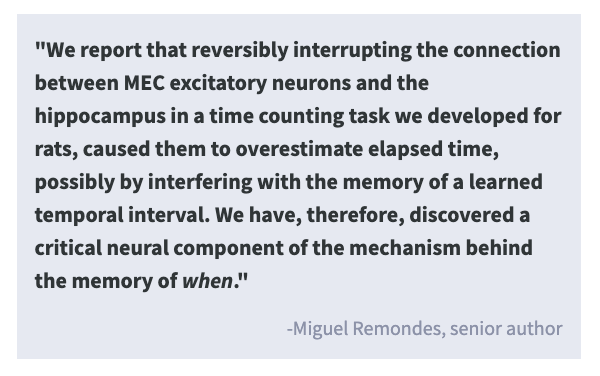The Medial Entorhinal Cortex is Necessary for Perception of Time Intervals
Post by Leanna Kalinowski
The takeaway
Connections between two brain regions - the hippocampus and medial entorhinal cortex - are responsible for perceiving and memorizing intervals of time. Neurons in the medial entorhinal cortex play an important role in reproducing these memorized time intervals.
What's the science?
Perceiving and memorizing intervals of time is important for our ability to interact with the changing world. The hippocampus has long been considered important for regulating memory of elapsed time. It receives input from the medial entorhinal cortex (MEC), primarily through the firing of neurons at specific time intervals. The time intervals at which these neurons fire are associated with elapsed time as measured by a clock. However, the specific role of MEC in time perception is still largely unknown. This week in The Journal of Neuroscience, Dias and colleagues examined the role of the MEC in time perception by disrupting MEC activity during a goal-directed timing task.
How did they do it?
To measure rats’ ability to tell time, the authors developed a goal-directed timing task called the Waiting-for-Trajectory (WfT) task. This task took place on a 2.0 m linear testing track: at one end of the track was the rats’ starting area, and at the other end of the track was a delivery pump for a chocolate milk reward. To receive the reward, rats were trained to voluntarily stop and wait at the starting area of the track for 2.5 seconds. If the rats left the waiting area before the 2.5 seconds elapsed, they did not receive a reward.
Once rats were trained on the WfT task, the researchers used a technique called chemogenetics, which is commonly used in neuroscience to directly manipulate the activity of neurons. First, the rats received an injection of a viral vector directly into the MEC. This viral vector then caused the MEC to express DREADDs (“designer receptor exclusively activated by designer drugs”) that “turn off” the neurons when the animals are given a substance called clozapine N-oxide (CNO). This allowed for the researchers to selectively “turn off” cells in the MEC. Following this procedure, rats underwent the WfT task daily for 10 consecutive days. Prior to each testing session, rats received daily alternating injections of either CNO (to “turn off” the MEC) or saline (to keep the MEC “on”), for a total of 5 CNO and 5 saline sessions per rat. The researchers measured the time that rats spent in the waiting area and classified each trial as a “hit” (staying in the waiting area for the full 2.5 seconds) or “miss” (prematurely leaving the waiting area).
What did they find?
First, the researchers found that “turning off” the MEC impaired rats’ ability to successfully complete the WfT task. These rats overestimated the amount of time spent waiting in the designated area, ended their waiting periods prematurely, and did not receive a reward. This suggests that activity in the MEC is necessary for the brain to accurately measure time.
To determine whether the memory of the target waiting time was affected by silencing the MEC, the researchers then used the individual waiting times from each trial to determine whether they would influence performance in subsequent trials. They found that waiting times and performance of any given trial were influenced by up to three of the preceding trials. They also found that “turning off” the MEC increased the number of consecutive misses (trials where rats stopped waiting prematurely). This suggests that decreasing activity in the MEC might influence the effects of trial history on timing behavior.
What's the impact?
Findings from this study reveal an important role of MEC neurons in the accurate reproduction of a memorized time interval. Specifically, these neurons may be responsible for maintaining a reference memory of important time intervals across multiple trials of a goal-directed timing test. These results aid in our understanding of how the brain measures and perceives time.


